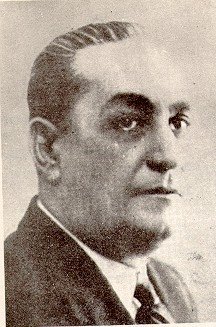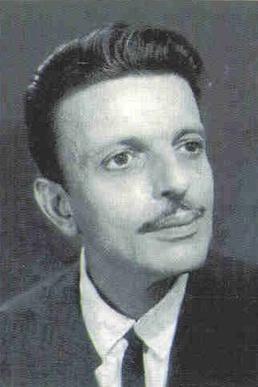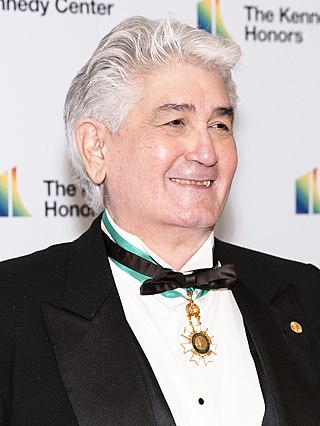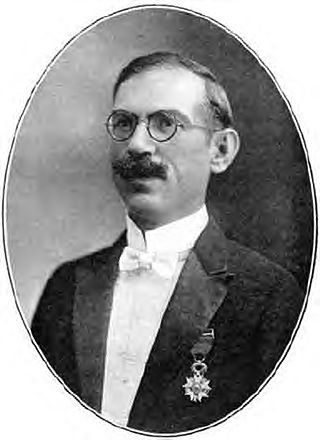
José Celso Barbosa Alcala was a Puerto Rican physician, sociologist and political leader. Known as the father of the statehood movement in Puerto Rico, Barbosa was the first Puerto Rican, and one of the first persons of African descent to earn a medical degree in the United States.

Cataño is a town and municipality located on the northeastern coast of Puerto Rico, bordering the San Juan Bay and the Atlantic Ocean, and adjacent to the north and east by San Juan; north of Bayamón and Guaynabo; east of Toa Baja and west of Guaynabo and is part of the San Juan Metropolitan Area. Cataño is spread over 7 barrios and Cataño Pueblo. It is part of the San Juan-Caguas-Guaynabo Metropolitan Statistical Area.

Pedro Albizu Campos was a Puerto Rican attorney and politician, and a leading figure in the Puerto Rican independence movement. He was the president and spokesperson of the Nationalist Party of Puerto Rico from 1930 until his death. He led the nationalist revolts of October 1950 against the United States government in Puerto Rico. Albizu Campos spent a total of twenty-six years in prison at various times for his Puerto Rican independence activities.

José de Diego y Martínez was a statesman, journalist, poet, lawyer, and advocate for Puerto Rico's political autonomy in union with Spain and later of independence from the United States who was referred to by his peers as "The Father of the Puerto Rican Independence Movement".

Luis Lloréns Torres, was a Puerto Rican poet, playwright, and politician. He was an advocate for the independence of Puerto Rico.

The Puerto Rico campaign was the American military sea and land operation on the island of Puerto Rico during the Spanish–American War. The offensive began on May 12, 1898, when the United States Navy attacked the capital, San Juan. Though the damage inflicted on the city was minimal, the Americans were able to establish a blockade in the city's harbor, San Juan Bay. On June 22, the cruiser Isabel II and the destroyer Terror delivered a Spanish counterattack, but were unable to break the blockade and Terror was damaged.

René Marqués was a Puerto Rican short story writer and playwright.
Dr. Luis Rafael Sánchez, a.k.a. "Wico" Sánchez is a Puerto Rican essayist, novelist, and short-story author who is widely considered one of the island's most outstanding contemporary playwrights. Possibly his best known play is La Pasión según Antígona Pérez, a tragedy based on the life of Olga Viscal Garriga.

Justino Díaz is a Puerto Rican operatic bass-baritone. In 1963, Díaz won an annual contest held at the Metropolitan Opera of New York, becoming the first Puerto Rican to obtain such an honor and as a consequence, made his Metropolitan debut in October 1963 in Verdi's Rigoletto as Monterone.

Puerto Rican literature is the body of literature produced by writers of Puerto Rican descent. It evolved from the art of oral storytelling. Written works by the indigenous inhabitants of Puerto Rico were originally prohibited and repressed by the Spanish colonial government.

The Cataño Ferry is a single-route ferry service between Cataño and San Juan, Puerto Rico. At its route's southwestern end is the AcuaExpreso Cataño Terminal in Cataño, while at its northwestern end is the AcuaExpreso San Juan Terminal, located at Pier 2 of the San Juan Port in Old San Juan.

Clemente Soto Vélez was a Puerto Rican nationalist, poet, journalist and activist who mentored many generations of artists in Puerto Rico and New York City. Upon his death in 1993, he left a rich legacy that contributed to the cultural, social and economic life of Puerto Ricans in New York and Latinos everywhere.

Eduardo Georgetti, was an agriculturist, businessman, philanthropist, and politician. Georgetti, who came from a family of landowners, became one of Puerto Rico's wealthiest sugar barons and benefactors. In 1917, he became the first vice-president of the Puerto Rican Senate.

José Luis González was a Puerto Rican essayist, novelist, short story writer, university professor, and journalist who lived most of his life in exile in Mexico due to his pro-independence political views. He is considered to be one of the most important Puerto Rican authors of the 20th century, particularly for his book Puerto Rico: The Four-Storeyed Country and Other Essays, which was first published in Spanish in 1980.

Yolanda Arroyo Pizarro is a Puerto Rican novelist, short-story writer and essayist.

Cayetano Coll y Cuchí was a politician, writer and an advocate of Puerto Rican Independence. In 1917, he became the first President of Puerto Rico House of Representatives after the island was ceded to the United States by Spain as a result of the Spanish–American War. Coll y Cuchí was a member of a prominent family of Puerto Rican politicians, writers and educators.

José S. Alegría was a poet, writer, lawyer and politician. Alegría was a founding member of the Puerto Rican Nationalist Party and president of the political organization from 1928 to 1930.

Leopoldo Figueroa a.k.a. "The deacon of the Puerto Rican Legislature", was a Puerto Rican politician, journalist, medical doctor and lawyer. Figueroa, who began his political career as an advocate of Puerto Rican Independence, was the co-founder of the "Independence Association", one of three political organizations which merged to form the Puerto Rican Nationalist Party. Figueroa, had changed political ideals and in 1948, was a member of the Partido Estadista Puertorriqueño. That year, he was the only member of the Puerto Rico House of Representatives who did not belong to the Partido Popular Democrático (PPD), and the only Representative to oppose the PPD's approval of what became known as the Ley de la Mordaza, which violated the civil rights of those who favored Puerto Rican Independence. On December 22, 2006, the Puerto Rican Legislature approved a law declaring every September 21, Leopoldo Figueroa Carreras Day.
Emilio Díaz Valcárcel was an acclaimed Puerto Rican writer who won several awards. He addresses numerous social issues in his novels, short stories, and plays.















